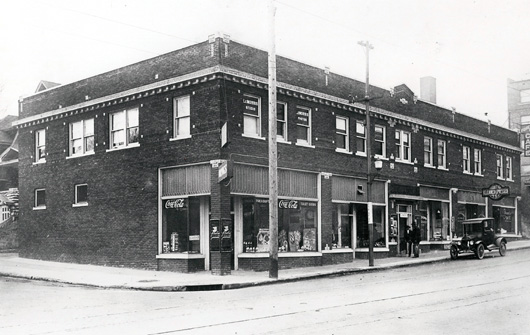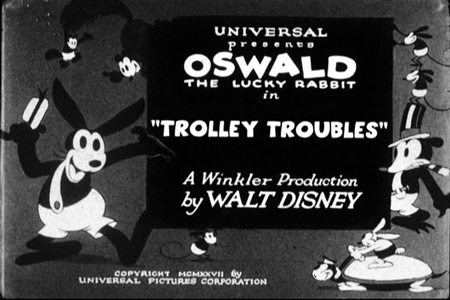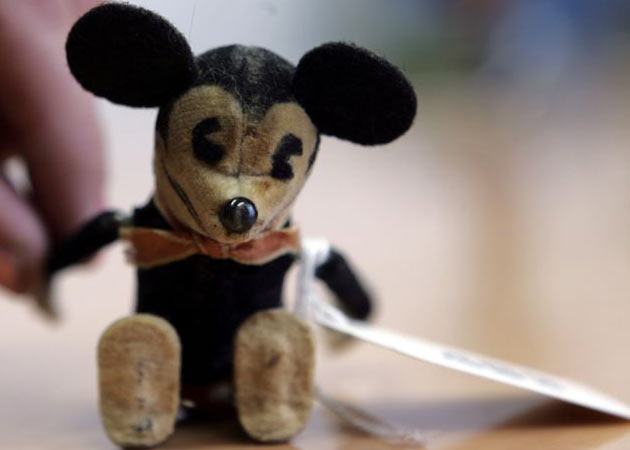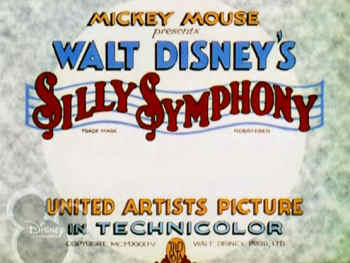Laugh-O-Gram Studio
Presented as "Newman Laugh-O-Grams", Disney's cartoons became widely popular in the Kansas City area. Through their success, Disney was able to acquire his own studio, also called Laugh-O-Gram, and hire a vast number of additional animators, including Fred Harman's brother Hugh Harman, Rudolf Ising, and his close friend Ubbe Iwerks. Unfortunately, with all his high employee salaries unable to make up for studio profits, Walt was unable to successfully manage money. As a result, the studio became loaded with debt and wound up bankrupt. Disney then set his sights on establishing a studio in the movie industry's capital city, Hollywood, California.
Hollywood
Disney and his brother pooled their money to set up a cartoon studio in Hollywood. Needing to find a distributor for his new Alice Comedies — which he started making while in Kansas City, but never got to distribute — Disney sent an unfinished print to New York distributor Margaret Winkler, who promptly wrote back to him. She was keen on a distribution deal with Disney for more live-action/animated shorts based upon Alice's Wonderland.
Alice Comedies
Virginia Davis (the live-action star of Alice’s Wonderland) and her family were relocated at Disney's request from Kansas City to Hollywood, as were Iwerks and his family. This was the beginning of the Disney Brothers' Studio. It was located on Hyperion Avenue in the Silver Lake district, where the studio remained until 1939. In 1925, Disney hired a young woman named Lillian Bounds to ink and paint celluloid. After a brief period of dating her, the two got married the same year.
The new series, Alice Comedies, was reasonably successful, and featured both Dawn O'Day and Margie Gay as Alice. Lois Hardwick also briefly assumed the role of Alice. By the time the series ended in 1927, the focus was more on the animated characters, in particular a cat named Julius who resembled Felix the Cat, rather than the live-action Alice.
Oswald the Lucky Rabbit
By 1927, Charles B. Mintz had married Margaret Winkler and assumed control of her business, and ordered a new all-animated series to be put into production for distribution through Universal Pictures. The new series, Oswald the Lucky Rabbit, was an almost instant success, and the character, Oswald — drawn and created by Iwerks — became a popular figure. The Disney studio expanded, and Walt hired back Harman, Rudolph Ising, Carman Maxwell, and Friz Freleng from Kansas City.
In February 1928, Disney went to New York to negotiate a higher fee per short from Mintz. Disney was shocked when Mintz announced that not only he wanted to reduce the fee he paid Disney per short but also that he had most of his main animators, including Harman, Ising, Maxwell, and Freleng (notably, except Iwerks, who refused to leave Disney) under contract and would start his own studio if Disney did not accept the reduced production budgets. Universal, not Disney, owned the Oswald trademark, and could make the films without Disney. Disney declined Mintz's offer and lost most of his animation staff.
With most of his staff gone Disney now found himself on his own again. It took Disney's company 78 years to get back the rights to the Oswald character. The Walt Disney Company reacquired the rights to Oswald the Lucky Rabbit from NBC Universal in 2006, through a trade for longtime ABC sports commentator Al Michaels.
Mickey Mouse
After losing the rights to Oswald, Disney felt the need to develop a new character to replace him. He based the character on a mouse he had adopted as a pet while working in a Kansas City studio. Ub Iwerks reworked on the sketches made by Disney so that it was easier to animate it. However, Mickey's voice and personality was provided by Disney. In the words of a Disney employee, "Ub designed Mickey's physical appearance, but Walt gave him his soul”. Besides Oswald and Mickey, a similar mouse-character is seen in Alice Comedies which featured a mouse named Ike the Mouse, and the first Flip the Frog cartoon called Fiddlesticks, which showed a Mickey Mouse look-alike playing fiddle. The initial films were animated by Iwerks, his name was prominently featured on the title cards. The mouse was originally named "Mortimer", but later christened "Mickey Mouse" by Lillian Disney who thought that the name Mortimer did not fit. Mortimer later became the name of Mickey's rival for Minnie, who was taller than his renowned adversary and had a Brooklyn accent.
The first animated short with Mickey in it was titled, Plane Crazy, which was, like all of Disney's previous works, a silent film. After failing to find a distributor for Plane Crazy or its follow-up, The Gallopin' Gaucho, Disney created a Mickey cartoon with sound called Steamboat Willie. A businessman named Pat Powers provided Disney with both distribution and Cinephone, a sound-synchronization process. Steamboat Willie became an instant success, and Plane Crazy, The Galloping Gaucho, and all future Mickey cartoons were released with soundtracks. Disney himself provided the vocal effects for the earliest cartoons and performed as the voice of Mickey Mouse until 1946. After the release of Steamboat Willie, Walt Disney would continue to successfully use sound in all of his future cartoons, and Cinephone became the new distributor for Disney's early sound cartoons as well. Mickey soon eclipsed Felix the Cat as the world's most popular cartoon character. By 1930, Felix, now in sound, had faded from the screen, as his sound cartoons failed to gain attention. Mickey's popularity would now skyrocket in the early 1930s.
Silly Symphonies
Following the footsteps of Mickey Mouse series, a series of musical shorts titled, Silly Symphonies was released in 1929. The first of these was titled The Skeleton Dance and was entirely drawn and animated by Iwerks, who was also responsible for drawing the majority of cartoons released by Disney in 1928 and 1929. Although both series were successful, the Disney studio was not seeing its rightful share of profits from Pat Powers, and in 1930, Disney signed a new distribution deal with Columbia Pictures. The original basis of the cartoons were musical novelty, and Carl Stalling wrote the score for the first Silly Symphony cartoons as well.
Iwerks was soon lured by Powers into opening his own studio with an exclusive contract. Later, Carl Stalling would also leave Disney to join Iwerks' new studio. Iwerks launched his Flip the Frog series with first voice cartoon in color, "Fiddlesticks," filmed in two-strip Technicolor. Iwerks also created two other series of cartoons, the Willie Whopper and the Comicolor. In 1936, Iwerks shut his studio to work on various projects dealing with animation technology. He would return to Disney in 1940 and, would go on to pioneer a number of film processes and specialized animation technologies in the studio's research and development department.
By 1932, Mickey Mouse had become quite a popular cinema character, but Silly Symphonies was not as successful. The same year also saw competition for Disney grow worse as Max Fleischer's flapper cartoon character, Betty Boop, would gain more popularity among theater audiences. Fleischer was considered to be Disney's main rival in the 1930s, and was also the father of Richard Fleischer, whom Disney would later hire to direct his 1954 film 20,000 Leagues Under the Sea. Meanwhile, Columbia Pictures dropped the distribution of Disney cartoons and was replaced by United Artists. In late 1932, Herbert Kalmus, who had just completed work on the first three-strip technicolor camera, approached Walt and convinced him to redo Flowers and Trees, which was originally done in black and white, with three-strip Technicolor. Flowers and Trees would go on to be a phenomenal success and would also win the first Academy Award for Best Short Subject: Cartoons for 1932. After Flowers and Trees was released, all future Silly Symphony cartoons were done in color as well. Disney was also able to negotiate a two-year deal with Technicolor, giving him the sole right to use three-strip Technicolor, which would also eventually be extended to five years as well. Through Silly Symphonies, Disney would also create his most successful cartoon short of all time, The Three Little Pigs, in 1933. The cartoon ran in theaters for many months, and also featured the hit song that became the anthem of the Great Depression, "Who's Afraid of the Big Bad Wolf". Source:Wikipedia
Thank You For Reading
Have a Disney Day!!!










 sfd
sfd
1 comment:
YAY! I can comment!!!
Nada era que queria mencionar que voy a ir a ver el edificio del Laugh O Gram studios pq voy pa Kansas City antes de ir a Orlando para ver a mi hermano y ya tenía planeado ir a ver el sitio! :D
Post a Comment